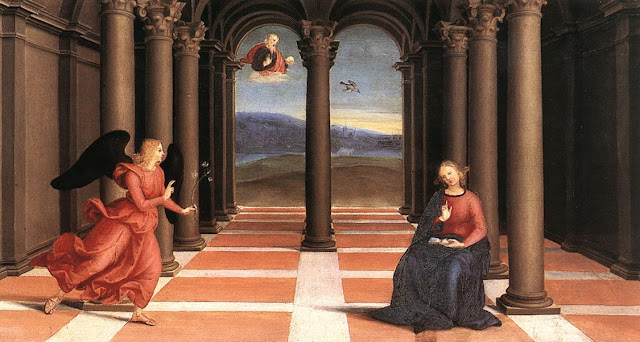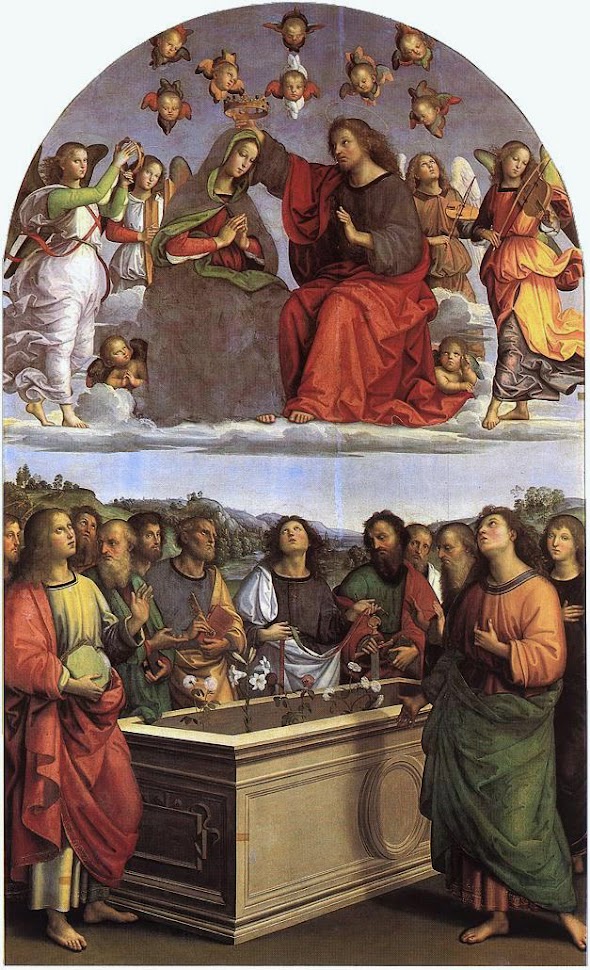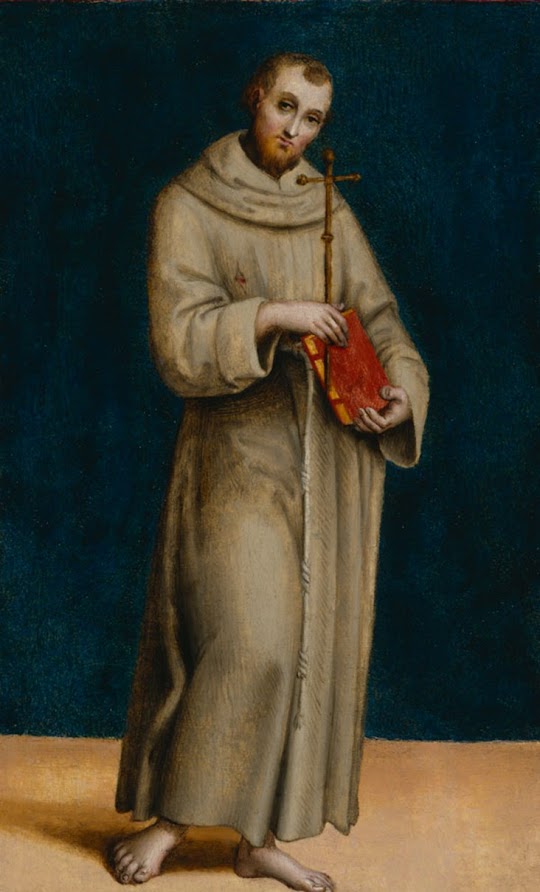For centuries Raphael has been recognised as the supreme High Renaissance painter, more versatile than Michaelangelo and more prolific than their older contemporary Leonardo. Though he died at 37, Raphael's example as a paragon of classicism dominated the academic tradition of European painting until the mid-19th century.
Raphael (Raffaello Santi) was born in Urbino where his father, Giovanni Santi, was court painter. He almost certainly began his training there and must have known works by Mantegna, Uccello, and Piero della Francesca from an early age. His earliest paintings were also greatly influenced by Purgino. From 1500 - when he became an independent master - to 1508 he worked throughout central Italy, particularly Florence, where he became a noted portraitist and painter of Madonnas.
In 1508, at the age of 25, he was called to the court of Pope Julius II to help with the redecoration of the papal apartments. In Rome he evolved as a portraitist, and became one of the greatest of all history painters.
He remained in Rome for the rest of his life and in 1514, on the death of Bramante, he was appointed architect in charge of St Peter’s.
For earlier works see part 1 also.
This is part 2 of 5 parts on the works of Raphael:
 |
| c1503-1505 The Tree Graces oil on panel 17.1 x 17.1 cm Musée Condé, Chantilly, France |
 |
| c1503 Madonna and Child with the Book oil on panel 55.2 x 40 cm Norton Simon Museum, Pasadena, CA |
 |
| 1504 The Marriage of the Virgin oil on panel 170 x 118 cm Pinacoteca di Brera, Milan, Italy |
 |
| 1504-1505 Four standing Soldiers pen and brown ink, possibly with some later reworking, on paper 27.1 x 21.6 cm Ashmolean Museum, University of Oxford, UK c150-05 Madonna Terranuova |
This was painted shortly after Raphael’s arrival in Florence and “was his fi rst attempt at the tondo format that was so popular in that city. The Madonna’s face was much more confidently composed than in his three earlier Berlin paintings. Leonardo’s influence is becoming stronger than Perugino’s. Details like the extreme foreshortening of Mary’s hand come from Leonardo, and possibly also the idea of showing the Christ Child with his legs crossed, although this pose could also derive from the Netherlands and a painter like Memling, for example, who is also echoed in the lavish attention paid to the landscape area. Northern aspects of the town featured more conspicuously in the under-drawing. A typically southern feature is the presence of holy children, above all the young John the Baptist.
 |
| c1504-1505 Madonna Terranuova oil on poplar wood panel 88.5 diameter Gemäldegalerie, Staatliche Museen zu Berlin |
 |
| c1504-1505cPortrait of Elisabetta Gonzaga (attributed to) oil on panel 52.5 x 37.3 cm Uffizi Gallery, Florence |
 |
| c1504-1505 Portrait of Emilia Pia da Montefeltro 42.5 x 28.6 cm oil on wood panel Baltimore Museum of Art, MD |
 |
| c1504-1505 St. Michael oil on wood panel 30 x 26 cm Louvre, Paris |
 |
| c1504-1506 Portrait of Pietro Bembo oil on walnut panel 54 x 39 cm Museum of Fine Arts, Budapest |
 |
| c1504-1506 Self-Portrait tempera on panel 47.5 x 33 cm Uffizi Gallery, Florence |
1504 Marriage of the Virgin
This vision of the theme by Pietro Perugino is believed to be the inspiration for Raphael’s version, although it is now sometimes attributed to his pupil Lo Spagna. It depicts the marriage between Joseph and Mary, and is now in the Musée des Beaux-Arts of Caen, France. Initially commissioned to Pinturicchio for the recently completed cathedral of Perugia, Perugino took over the commission and finished the work around 1500–1504, probably after several periods of stasis.
 |
| 1504 Marriage of the Virgin oil on panel 174 x 121 cm Pinacoteca di Brera, Milan |
 |
| c1503-1504 The Marriage of the Virgin by Pietro Perugino oil on panel 234 x 185 cm Musée des Beaux-Arts de Caen, France |
1504-1507c Agnolo Doni
The two paintings portray Agnolo Doni (1474-1539), a rich fabric merchant and prominent figure among the Florentine upper class, and his wife, noblewoman Maddalena Strozzi (1489-1540), who married on 31 January 1504. Both portraits were painted "en pendant" and originally formed a diptych, held together by hinges that made it possible to look at the scenes painted on the backs.
 |
| c1504-1507 Agnolo Doni oil on wood panel 63 x 45 cm Palazzo Pitti, Florence |
 |
| c1504-1507 Maddalena Doni oil on basswood panel 63.5 x 45 cm Galleria Degli Uffizi, Florence |
 |
| 1504-1508 Female Figure with a Tibia pen and brown ink 30.5 x 18.9 cm The J. Paul Getty Museum, Los Angeles, CA |
c1504 An Allegory (Vision of a Knight)
Notes from The National Gallery
While resting in the shade of a bay tree, the young soldier Scipio has a vision of Virtue and her adversary Pleasure. Virtue promises Scipio honour, fame and glory through victory in war. Pleasure, with fragrant flowing hair, promises a life of ease and serenity. Raphael interpreted the theme not as a moral dilemma but as a combination of all the virtues to which an ideal soldier should aspire.
 |
| c1504 An Allegory ( Vision of a Knight ) oil on poplar panel 17.1 x 17.3 cm The National Gallery, London |
c1504 Madonna and Child Enthroned with Saints
Raphael painted this altarpiece around 1504/5 for the Franciscan convent of Sant’ Antonio in Perugia. It hung in a part of the church reserved for the nuns, who may have insisted on its conservative details, such as the elaborately clothed Christ Child. By contrast, the weighty male saints look to the future—the recent works by Leonardo da Vinci and Fra Bartolomeo that Raphael had just begun to study in Florence. The nuns sold their altarpiece in 1678, and in the early twentieth century its purchase by J. Pierpont Morgan received clamorous press coverage.
 |
| c1504 Madonna and Child Enthroned with Saints tempera and oil on wood panel 169.5 x 168.9 cm (painted surface) Metropolitan Museum of Art, New York |
 |
| c1504 Madonna of the Pomegranate black-grey chalk 40.3 x 29.1 cm Albertina, Vienna |
 |
| c1504 The Agony in the Garden oil on wood panel 24.1 x 28.9 cm Metropolitan Museum of Art, New York |
 |
| 1505 Madonna and Child with the Infant Saint John the Baptist oil on wood panel 101 x 87 cm Kunsthistorisches Museum, Vienna |
 |
| 1505 Madonna and Child with the Infant Saint John the Baptist study red chalk 22.4 x 15.8 cm Metropolitan Museum of Art, New York |
 |
| 1505 Portrait of Francesco Maria I della Rovere oil on wood panel 48 x 35.5 cm Uffizi Gallery, Florence |
1505 Saint John the Baptist Preaching
Notes from The National Gallery
This painting is the only surviving scene from the predella (base) of Raphael’s altarpiece for the Ansidei chapel in S. Fiorenzo, Perugia. The main panel of the altarpiece, ‘The Ansidei Madonna’, is also in the National Gallery’s collection. This predella panel would have been placed beneath the figure of John the Baptist. Below Saint Nicholas was a shipwreck, probably relating to one of the miracles he performed. That scene seems not to have survived.
John the Baptist appears as the forerunner of Christ, preaching to a crowd of men (Luke 3: 1–17). He can be identified by his traditional camel-skin costume, which he wears beneath a billowing red mantle, and by the thin reed cross in his left hand. He points towards heaven, referring to the coming of Christ. When the altarpiece was intact, he would also have been pointing to the identically dressed Baptist in the main panel above, who points towards the infant Christ.
 |
| 1505 Saint John the Baptist Preaching oil on poplar panel 26.2 x 52 cm The National Gallery, London |
1505 The Ansidei Altarpiece
Notes by The National Gallery
This is the main panel of the altarpiece Raphael painted for the Ansidei family chapel in the Servite Church of S. Fiorenzo in Perugia in 1505. The Virgin sits in majesty on a carved wooden throne with the Christ Child on her lap. She draws his attention to a passage in the book on her knee. A string of coral beads ending in jewelled crosses like a rosary is suspended from the throne, a reminder of the blood Christ will shed at the Crucifixion. The Latin inscription, ‘Salve Mater Christi’ (Hail Mother of Christ), would have acted as a prompt to the recitation of the rosary. John the Baptist points to the infant Christ and gazes at his own cross, in foreknowledge of Christ’s future death. Saint Nicholas concentrates on his book. Raphael carefully calculated the geometry of the composition, using an incised grid to divide it horizontally and vertically into harmonious thirds before he began painting.
 |
| 1505 Saint John the Baptist Preaching oil on poplar wood panel 26.2 x 52 cm National Gallery, London |
 |
| 1505 Saint John the Baptist Preaching detail |
 |
| 1505 Saint John the Baptist Preaching detail |
 |
| 1505 The Ansidei Madonna oil on poplar wood 216.8 x 147.6 cm National Gallery, London |
c1504-1505 The Procession to Calvary
Notes from The National Gallery
Altarpiece painted for the convent of S. Antonio da Padua in Perugia. The Procession to Calvary was the central scene of the predella, positioned below the main panel of the altarpiece. Christ looks to us as he carries the Cross, helped by Simon of Cyrene and escorted by five foot soldiers. The Virgin Mary is supported by the Three Marys and accompanied by Saint John the Evangelist, who wrings his hands in grief. The three distinct groups of the procession are linked together by a rhythm of repeated colour and by the figures who look back over their shoulders at the groups behind. Several of the figures show the influence of other artists, including Leonardo, Filippino Lippi and Justus of Ghent, demonstrating how Raphael was assimilating different approaches and ideas into his own developing style during this early period of his career.
 |
| c1505-05c The Procession to Calvary oil on poplar panel 24.4 x 85.5 cm The National Gallery, London |
 |
| c1505-05 The Procession to Calvary detail |
 |
| c1505-05 The Procession to Calvary detail |
 |
| 1505-1506 La Donna Gravida oil on panel 66 x 52 cm Palantine Gallery, Pitti Palace, Florence |
 |
| 1505-1506 Madonna in the Green oil on poplar wood 113 x 88.5 cm Kunsthistorisches Museum Vienna ©KHM-Museumsverband |
 |
| 1505-1506 Madonna of the Goldfinch oil on panel 107 x 77 cm Uffizi Gallery, Florence, Italy |
 |
| 1505-1506 The Lamentation of Christ pen and ink oner stylus and black chalk 33.4 x 39.7 cm |
 |
| c1505-1506 Christ Blessing oil on wood panel 31.7 x 25.3 cm Pinacoteca Tosio Martinengo, Brescia, Lombardy, Italy |
c1505-1506 Portrait of a young Woman with a Unicorn
The painting was originally oil on panel, and was transferred to canvas during conservation work in 1934. It was in the course of this work that overpainting was removed, revealing the unicorn, removing the wheel, cloak, and palm frond that had been added by an unknown painter during the mid-17th century.
The composition of the picture—placing the figure in a loggia opening out onto a landscape, the three-quarter length format—was apparently inspired by the Mona Lisa, painted by Leonardo between 1503 and 1506. Christof Thoenes observes: "However unabashedly Raphael adopts the pose, compositional framework and spatial organization of the Leonardo portrait...the cool watchfulness in the young woman's gaze is very different" from the "enigmatic ambiguity" of Mona Lisa.
 |
| c1505-1506 Portrait of a young Woman with a Unicorn oil on canvas 65 x 51 cm Galleria Borghese, Rome |
 |
| c1505-1506 The Canigiani Holy Family oil on poplar wood panel 131 x 107 cm Alte Pinakothek, Bayerische Staatsgemäldessammlungen, Munich |
 |
| c1505-1507 Madonna with beardless St. Joseph oil and tempera on canvas, transferred from panel 72.5 x 56.5 cm Hermitage Musem, St. Petersburg, Russia |
 |
| c1505-1507 The Grand Duke's Madonna oil on panel 84.4 x 55.9 cm Palantine Gallery, Pitti Palace, Florence |






































